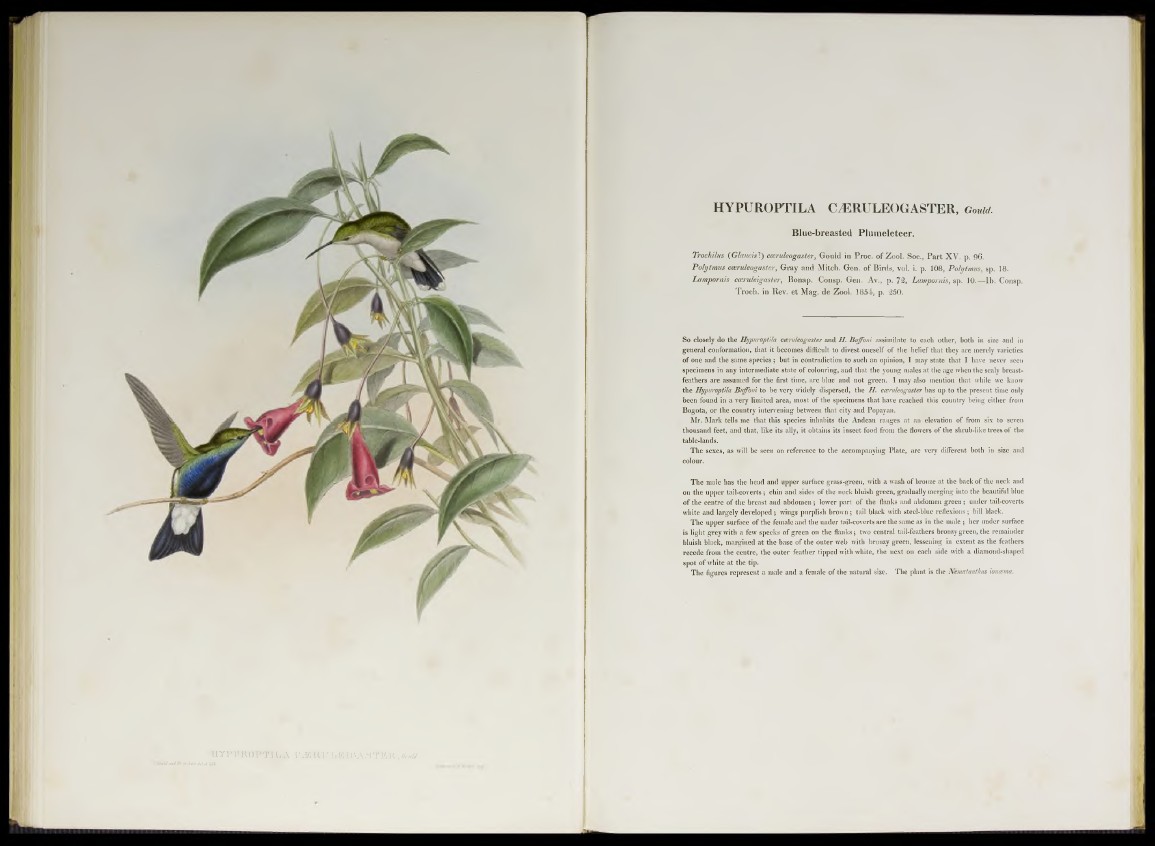
HT PlimO FTBLA C JB M IL E IG A J S T E E ,M
wiU/utlUCJhch/v, JA. tl luk.
HYPUROPTILA (LERULEOGASTER, Gould.
Blue-breasted Plumeleteer.
Trochilus (GlaucisT) cceruleogaster, Gould in Proc. of Zool. Soc., P a rt XV. p. 96.
Polytmus cceruleogaster, Gray and Mitch. Gen. of Birds, vol. i. p. 108, Polytmus, sp. 18.
Lampornis cceruleigaster, Bonap. Consp. Gen. Av., p. 72, Lampornis, sp. 10.—Ib. Consp.
Trocb. in Rev. et Mag. de Zool. 1854, p. 250.
So closely do the Hypuroptila cceruleogaster and H. Buffbni assimilate to each other, both in size and in
general conformation, that it becomes difficult to divest oneself of the belief that they are merely varieties
of one and the same species ; but in contradiction to such an opinion, I may state that I have never seen
specimens in any intermediate state of colouring, and that the young males at the age wlien the scaly breast-
feathers are assumed for the first time, are blue and not green. I may also mention that while we know
the Hypuroptila Buffoni to be very widely dispersed, the H cceruleogaster has up to the present time only
been found in a very limited area, most of the specimens that have reached this country being either from
Bogota, or the country intervening between that city and Popayan.
Mr. Mark tells me that this species inhabits the Andean ranges at an elevation of from six to seven
thousand feet, and that, like its ally, it obtains its insect food from the flovvers of the shrub-like trees of the
table-lands.
The sexes, as will be seen on reference to the accompanying Plate, are very different both in size and
colöur.
The male has the head and upper surface grass-green, with a wash of bronze at the back of the neck and
on the upper tail-coverts; chin and sides of the neck bluish green, gradually merging into the beautiful blue
of the centre of the breast aud abdomen; lower part of the flanks and abdomen green; under tail-coverts
white and largely developed ; wings purplish brown; tail black with steel-blue reilexions; bill black.
The upper surface of the female and the under tail-coverts are the same as in the male ; her under surface
is light grey with a few specks of green on the flanks; two central tail-feathers bronzy green, the remainder
bluish black, margined at the base of the outer web with bronzy green, lessening in extent as the feathers
recede from the centre, the outer feather tipped with white, the next on each side with a diamond-shaped
spot of white at the tip.
The figures represent a male and a female of the natural size. The plant is the Nematanthus ioncema.